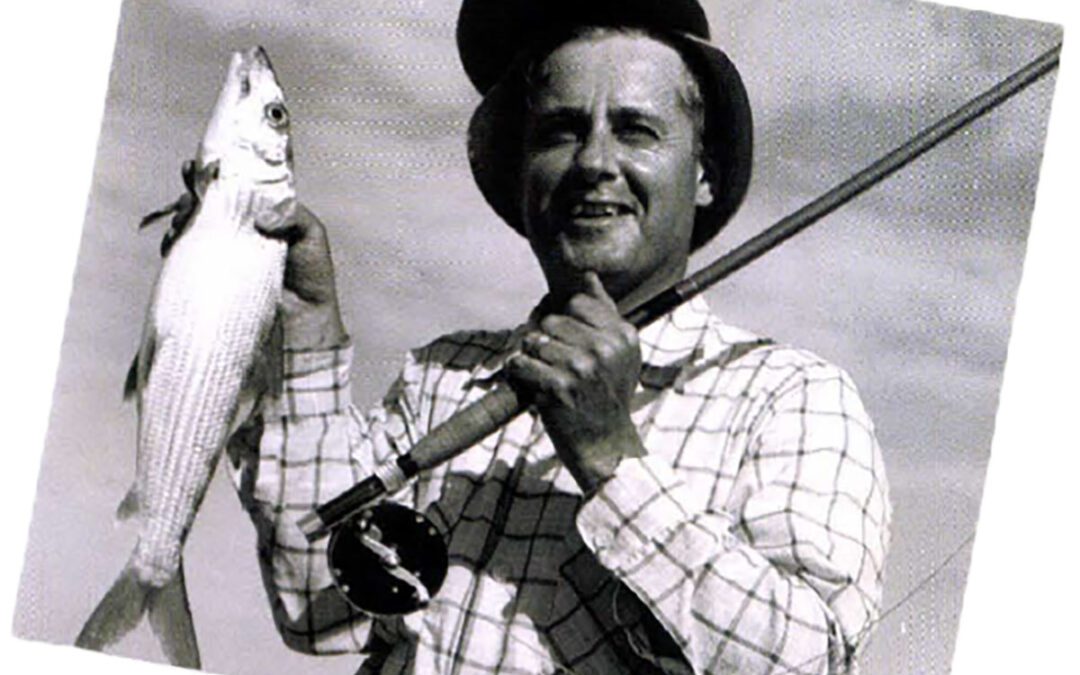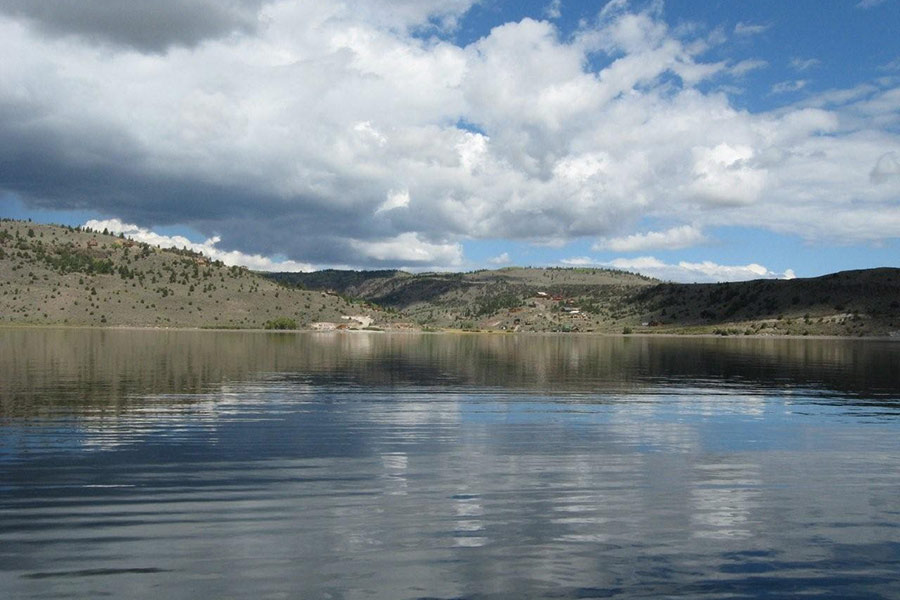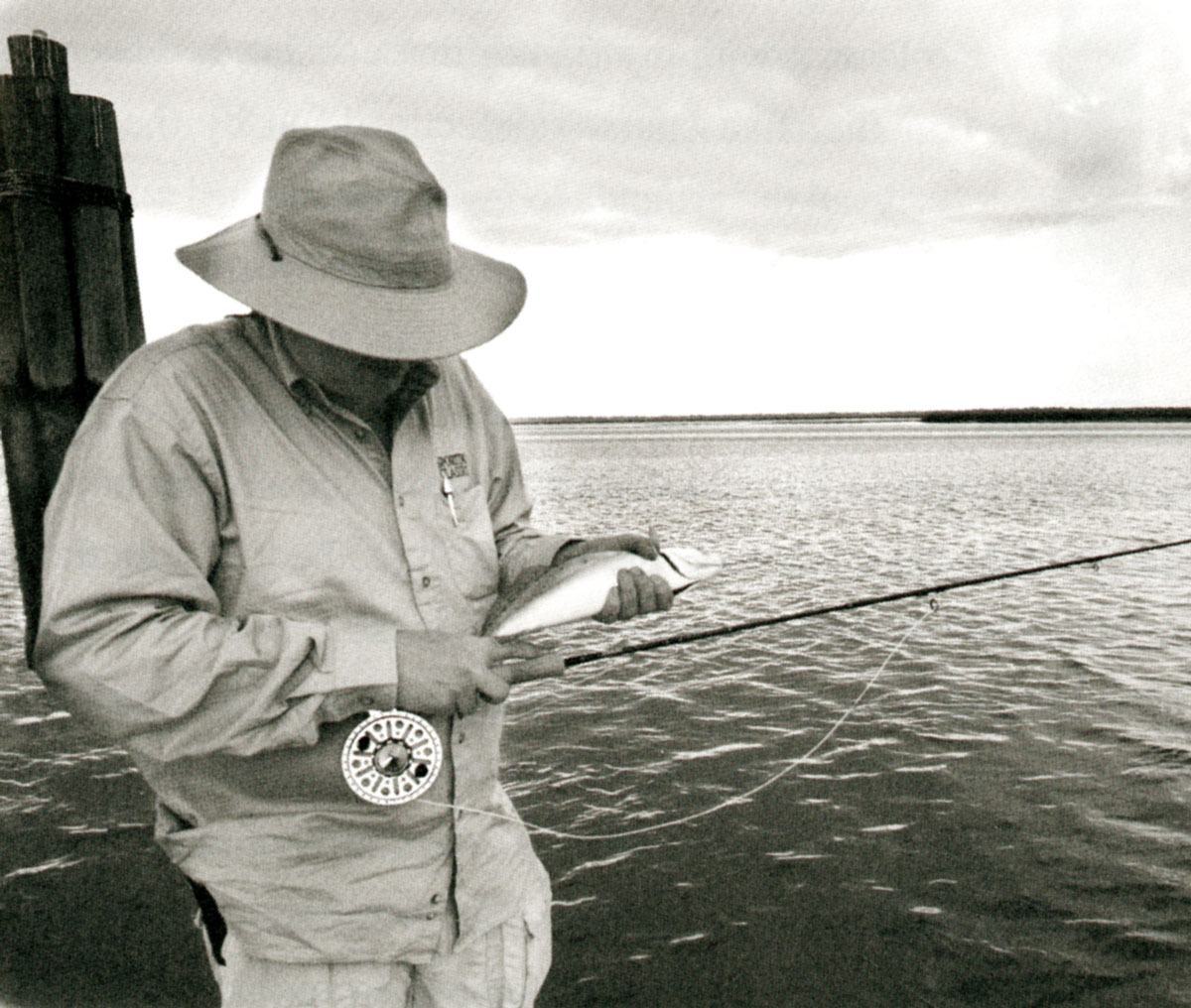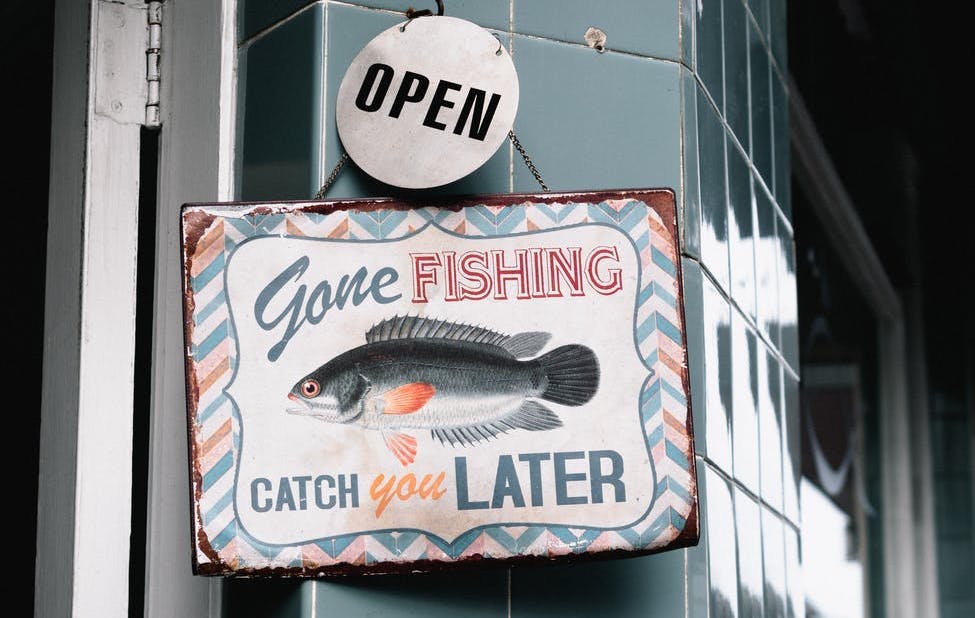Curt Gowdy left a legacy that will never be equaled.
Baseball broadcasts would run spring to fall; football carried from fall to winter and basketball into the spring. But Sunday afternoons from January to March, with snow packed at the foot of millions of doors, part of the warmth felt within came via the TV airwaves from the same pleasing, smooth voice that brought Americans three of their favorite pastimes the rest of the year.
The national voice of the outdoors was The American Sportsman himself, Curt Gowdy, who brought fishing and hunting to our TV sets from the mid ’60s to the late ’80s. Behind the microphone Gowdy’s work spanned more than seven decades, making him one of the most famous and instantly recognizable broadcast voices for over half of his illustrious career. His love for the outdoors — especially for flyfishing — bridged an even wider eight decades.
He was an institution in sports who worked for all four major networks as well as cable. Even before his death in February of 2006, at 86, Gowdy was sought out for special TV assignments, voice-overs and after-dinner speeches.
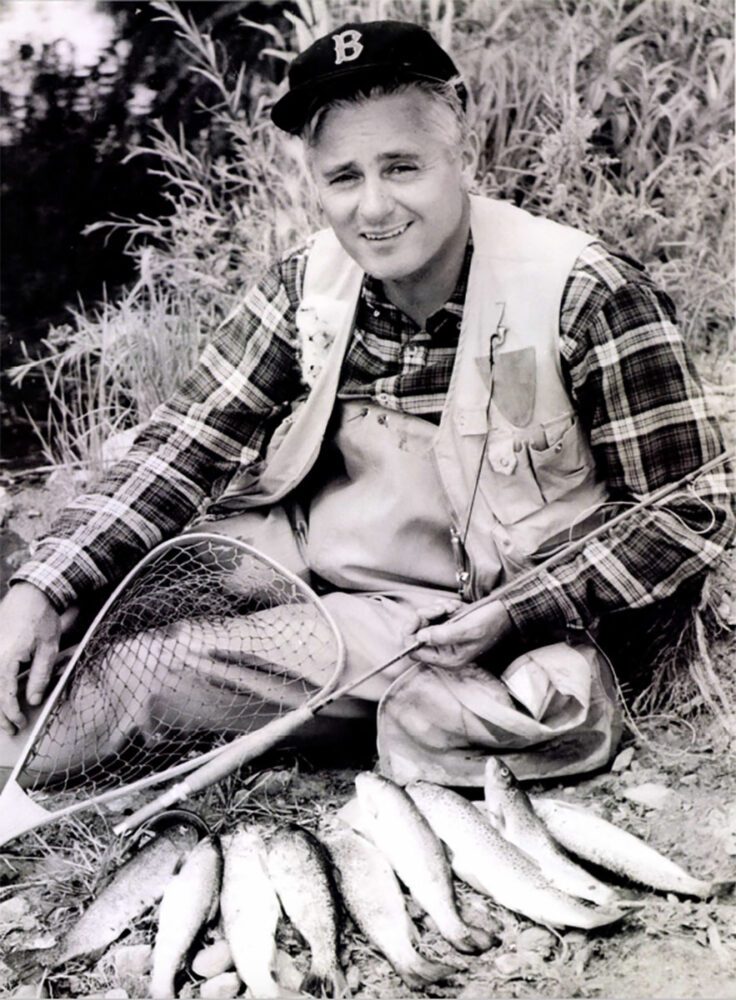
The American Sportsman himself.
Curtis Edward Gowdy was born in 1919 in Green River, Wyoming, the oldest of two children in a close-knit family. While his father Ed, a railroad dispatcher for Union Pacific, taught him fly fishing, hunting and a deep love and respect for the Wyoming outdoors, it was his mother Ruth who made sure he got the education a boy living in the rugged West needed. Curt called it “tough love” something he said more of modem society needs.
At age six it was a library card and a book a week. “Each day she set aside time for reading; classic books that taught lessons in morality, values and integrity while allying a love for nature,” he reflected.
At ten it was elocution lessons. “She wouldn’t stand for unintelligible speech. I thought it was silly at the time and told her, ‘Aw geez, mom, c’mon! We’re living in Cheyenne, Wyoming! Elocution lessons? How is this gonna do me any good?’ And in my senior year she wanted me to take typing. It was embarrassing, to be the only boy in a classroom of 35giggling girls. But years later in my professional career I would type over a hundred words a minute.”
Gowdy was an outstanding basketball and tennis player at the University of Wyoming, where he graduated with a degree in business. Unfortunately, his athletic career was cut short by World War II and a serious spinal injury that he would suffer with over much of his life. In 1943, after surgery and his discharge from the Army Air Corp, he began his broadcasting career backed with a journalism stint in his hometown of Cheyenne.
“It was a fluke,” Gowdy said of his entry into broadcasting. “Otherwise, I would have probably gone into something like statistics.
“The manager at a small, local radio station asked if I would do a live broadcast of a six-man high school football game. My mother encouraged me to do it to ‘take my mind off my back problems.’ Other than a single public speaking class I took at Wyoming or acting like a Sportscaster when listening to a radiobroadcast as a child, I had no real experience.
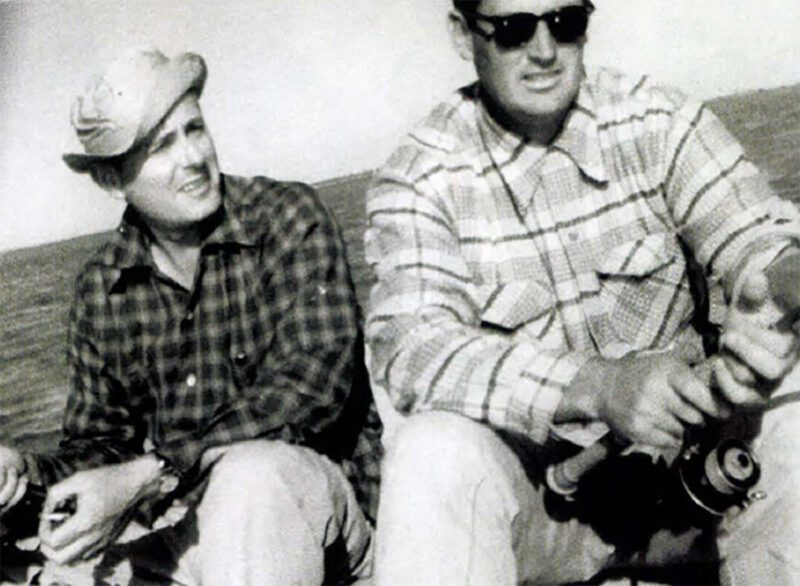
With Ted Williams
“It was a cold day and only about 15 people in the stands. There were two boxes, one for me to sit on and the other for the microphone. There was no roster, no numbers on the player’s jerseys, no yard-lines, and I had to guess where the goal-line was,” he smiled. “I took some liberty making up names of the players, many of them guys I had met in the Air Force or played against in basketball. The sponsor liked the broadcast and the station offered me a job announcing high school basketball as well.”
Over the next 20 years, Gowdy’s career bounced from local to regional (Oklahoma for college football and basketball, and minor league baseball followed by 15 years as the voice of the Boston Red Sox), and then national network TVand radio — and the start of The American Sportsman series.
The American Sportsman series had its origins in a segment for ABC’s Wide World of Sports, filmed in 1962 and aired the following year. Roone Arledge, head of ABC Sports, knew of Gowdy’s love for the outdoors and approached him with the idea of a “three-day spin and fly world championship trout contest.” Legendary writer and angler Joe Brooks, who had fished with Curt in Cuba and the Florida Keys, would be his partner.
“Brooks and I represented the United States, without asking anybody. The trip took days to reach Lago General Paz, a very remote lake on the border of Argentina and Chile. We won in the last five minutes over two top Argentinean anglers.”
That first competitive fishing segment (aired in 1963) was a hit and launched The American Sportsman the following year. The second year the show’s staff began inviting careful to pick only those who liked to hunt and fish. Two men who helped to preserve the show’s high quality were writer Pat Smith and head cameraman Bruce Buckley who Gowdy said rarely took the 19-pound camera off his shoulder.
“He seldom missed the action, capturing some of the most exciting fishing and hunting scenes in the series’ history. “Each year I would produce eight segments myself and do a lot of them in the Keys.”
Curt filmed with several giants of the outdoors, including Lee and Joan Wulff, Lefty Kreh, Bill Curtis and many famous entertainers and sports figures of the day. His trips took him to Scotland for grouse hunting with race car driver Jackie Stewart; to Hawaii for marlin fishing with “tough guy” actor Lee Marvin; Africa with actor Peter O’Toole and the mountain streams of New Zealand for trout.
“Bing (Crosby) and Phil (Harris) were the original song and dance men of the outdoors. Crosby was one of the nicest and most humble men I’ve ever been around and a better fisherman than Harris. Bing would say ‘Curt, those fish don’t care how wealthy I am. They always humble me and that’s what makes it so exciting.'”
Actor, bandleader, singer and imbiber Phil Harris was one of Gowdy’s favorites right from their initial meeting.
“After broadcasting a college football game, I flew in late the night before filming. Early the next morning, I walked into the lodge’s breakfast area and there was Phil sitting alone as the cook worked in the kitchen.
“I introduced myself, calling him Mr. Harris and he said ‘I know who you are Curt, and please just call me Phil.’ We sat down to breakfast and throughout the meal he keeps saying things like ‘Jack, we’re going to have a great day’ or ‘Jack, the pheasant hunting will be fabulous!’
“Now I’m worried that when we start filming Phil will be calling me Jack on camera, so at the end of the meal I reminded him my name is Curt. ‘No, I wasn’t referring to you Curt, I was referring to my friend Jack here,’ pulling a stocking cap off a bottle of Jack Daniels he had sitting on the table.
“On a duck hunting show, Bing and Phil had me setting the decoys. They’re in the blind and Bing says, ‘He sets a nice decoy doesn’t he?’ Phil agrees, ‘Oh yeah, I like the way he does it,’ and they go on and on about it. I get back in the blind and they say, ‘Nice job, Curt … you really did that well. Now let’s see if you can hunt.’ They’d sing and laugh it up. Both were excellent sportsmen and we had them on nine different times. This was their chance to get away from Hollywood. For me, it was some of the best times of my life.”
Another favorite pair was comedian Jonathan Winters and actor Ernest Borgnine who were big fishing buddies.
“Winters was at the height of his career when we first approached him. He said he’d do the show if it was someplace that people wouldn’t bother him. I replied that no one would recognize him in the Florida Keys.
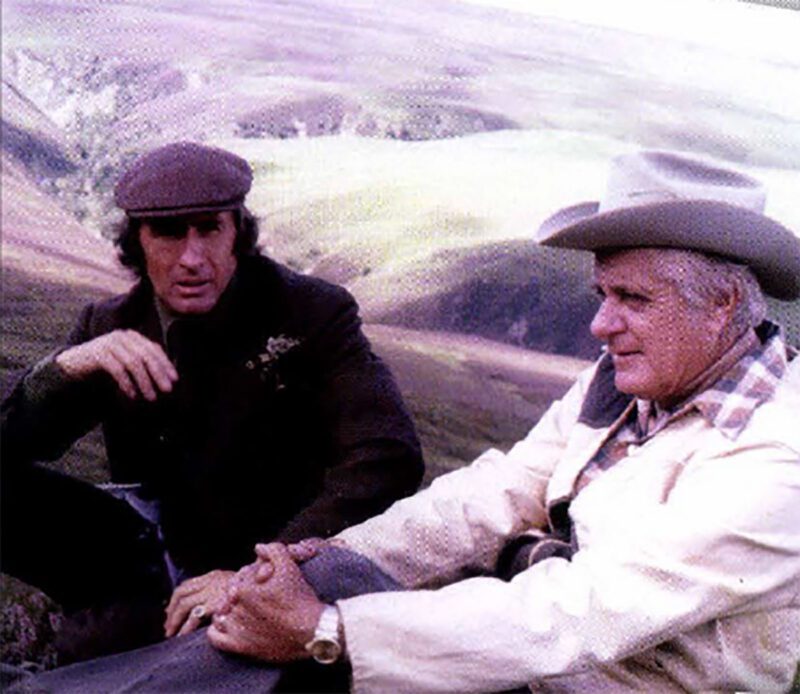
With Jackie Curt
“Well, the second day of filming over sunken wrecks for amberjack and cobia he’s unhappy saying, ‘No one knows me down here.’ I said, ‘That’s what you wanted. I told you the people down here are funny and they won’t bother you.’ He began doing his routines in the motel parking lot trying to attract a crowd. And each night after dinner he’d do a 30-minute routine and have everyone in stitches just as he had on the boat. Winters was the greatest ad libber I ever heard, and Borgnine was a straight man for him. They teamed great together.”
While filming a fly fishing show with President Jimmy Carter and his wife, Rosalynn, in Canada, Gowdy said the reel came off her fly rod and dropped into the river.
“I jumped out of the boat and went underwater to get her reel back. She’s now hooked this big salmon and plays him with the reel still off. We taped the reel back to the rod and she finally landed a 25-pounder. As we got a good close-up of it, I said That was some catch, Mrs. Carter,’ and she held up her hand with a smile and said, ‘And only one broken fingernail.'”
Gowdy said all of the shows were his favorites, but particularly the one that featured him by fishing for trout with sons, Curt Jr. and Trevor, when they were ages 12 and nine in his home state of Wyoming.
“I took them back to the same spot in the Platte River I use to fish with my dad. We camped out and did everything like my dad and I did. I’ll never forget that show; it was very dear to me. Every chance I could, I’d try to fish with them.
“I did a lot of shows in Wyoming because I loved the state and its people. It’s a great outdoors state.”
His daughter, Cheryl Ann, also shared time behind the scenes as an associate producer on many of her father’s segments.
“In lining up academy award-winning actor Peter O’Toole, he told us what a great fisherman he was. We met him in the Okavango Delta in northern Botswana. But he couldn’t really fish or hunt. He could hardly hold a rod in his hands, but he loved the outdoors, to watch the birds and the animals.
“We were after tigerfish, one of the most sporting fish I ever caught, with a bad reputation and really long, needle-sharp teeth … really bad teeth. Peter finally caught one and it jumped like hell. And as it jumped (mimicking O’Toole, Curt’s voice rises to a falsetto), ‘Oh, I say old chap . .. oh, my darling … oh, oh, I say my old fellow …’ He’d talk to the fishlike that – like an excited Englishman.
“This was a classic African trip with us living in tents, which O’Toole hated, saying ‘Lawrence of Arabia ruined me for all the living in a tent in the desert during months of filming.’
“I got up one morning to continue filming and the crew said Peter’s gone. I said What do you mean he’s gone?’ He’d flown out to do some big game hunting. The production crew followed him to the new location and sent the plane back for me. O’Toole loved studying the wildlife so we filmed him watching the giraffes, hyenas and a rare opportunity of wild dogs close up, which was fantastic.
“Flying back through Johannesburg we met actress/model Lauren Hutton coming in with another crew to do a show with the pigmy tribes. She was one of the few females we had on the show.”
Former Boston Red Sox slugger Ted Williams, one of Gowdy’s best friends, was on the show twice.
“He was different than anyone else, but I got along with him famously. He studied everything and wanted to get better at it. Ted was a question-asker, a great brain-picker, a perfectionist and wanted to be Number One at whatever he did.
“We fly-fished the Keys for bonefish and tarpon. We’d go to Marco Island for the big snook. One of us would drive his station wagon; the other would stand on the tailgate, cruising by the canals or beach. When we’d spot some big snook, we’d jump off and cast to them, catching 30-40 pounders. It was great,” Curt recalled.
“We’re doing a show in LaPaz, Mexico for permit. The first day we saw a lot but didn’t get one. The same thing happened the second day and by the morning of the third day, still nothing. The producer said to me, ‘We’re going to have to can this show. We only have another day and a half and we need a fish. If we don’t get any fish we don’t have a show.’
Williams is listening and says ‘(Bleep),I bet you a thousand dollars I get a fish today. The producer was about to respond and I said, ‘Don’t bet him … believe me, he has such self-confidence.’ We went back to fishing and Williams caught one. Then I caught one and the next day we caught three more and had a great show.
“I never saw someone who had supreme confidence in himself in any circumstance, at the plate, in a fighter jet, on the water fly fishing … it didn’t matter. Ted always wanted to be the best and prepared himself for it.
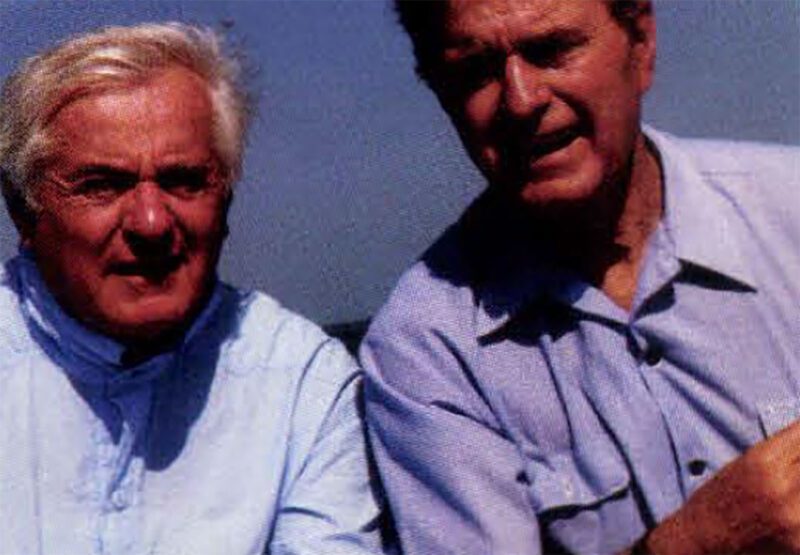
With President George Bush, Sr.
“Not only with fly fishing, but Ted Williams made me a better sportscaster. I saw the way he prepared. I said to myself. This guy is maybe the greatest hitter in the history of baseball. If he can work at it, why can’t I? So I really started preparing; little things, keeping records, subscribing to the newspapers of the baseball and football teams across the nation.”
Another memorable show was trout fishing in the Wyoming Tetons with actor William Conrad. “It was April but it was like a June day with the runoff of melting snow turning the water the color of chocolate milk, and the fishing off,” Gowdy recalled.
“Bill was great. He’d give me some criticisms and tips. I laughed and said, ‘Why don’t you direct the (bleeping)show?’ He smiled and said, ‘I will! I’m probably the best director in Hollywood but I never get a chance at directing.'”
Gowdy described one of the scenes: “The rains pouring off our hats and though we hadn’t caught any fish, I’m keeping up the enthusiastic chatter, saying, ‘Come on Bill, keep going, we’ll get them.’ He replied sarcastically, ‘Yeah, sure Curt, we’ll kill them today’ and he left.
“I caught a trout or two while he’d gone upstream and gotten a guideboat, then came floating by the camera holding a nice stringer of trout.
“Hey, how you doing there, Curt? You like fishing from the bank? Good luck, Curt,’ with the same enthusiasm I had used earlier. Then he and the guide drifted out of sight. It was great the way he did it.”
Many humorous moments with the celebrities took place off camera. One that did hit the airwaves in 1973 involved Terry Bradshaw, the Pittsburgh quarterback. Gowdy asked Capt. Bob Montgomery, one of the best Florida Keys guides, to teach Bradshaw the rudiments of fly fishing for100-pound-plus tarpon.
“Bradshaw had unbelievable eye-hand coordination and with Montgomery’s coaching, he was throwing a pretty tight line that first evening,” said Gowdy.
“The following morning, during our half-hour boat ride from Key West, both men are shouting over the loud drone of the twin outboards. Bradshaw’s like a little kid having learned a new skill and wanting to show it off; Montgomery tossing out more encouragement and advice, a perfect match of student and teacher.”
Shutting down on a favorite flat, Montgomery began push-poling Bradshaw and Gowdy. “Bradshaw looked ready, like he’d been up on the casting platform many times before, line coiled at his feet, rod in his right hand and the streamer fly between his left index finger and thumb,” said Gowdy. “But it was his first time and we’re asking a lot of Terry. Bob’s guiding him through the steps, telling him that the opportunity, like on the football field of picking up a receiver, could be mere seconds.”
“Montgomery spots a school of tarpon and he’s whispering to Terry and the camera crew in the other boat so they’ll see them too. Seconds later, pointing with his rod, Bradshaw says, ‘Okay, okay. I see them, Bob. I see them. Damn! Look at that!'”
Montgomery instructs Bradshaw to make the cast and it’s perfect. Without Bradshaw even making a ship, the tarpon moves for the fly and takes it.
“I’m watching with pride as Terry sets the hook; his first tarpon on his first try. But then the big fish turned, ripping the rod out of Terry’s hands.”
Terry immediately jumped into the water to recover the rod. As the camera and sound continued to record, Bradshaw reappeared with the rod held high, his floppy hat and golden hair plastered to his face while Gowdy and Montgomery rolled around on the deck, doubled over with laughter.
“Terry stands in the water, shaking his head, laughing at himself and repeating one line: ‘I can’t believe I did that.'”
Gowdy said Terry loved the episode, which was featured during Curt’s 2003 induction into the International Game Fish Association’s Fishing Hall of Fame in Dania Beach, Florida — one of 21 halls of fame he’s been inducted into — and plays every day to the delight of visitors.
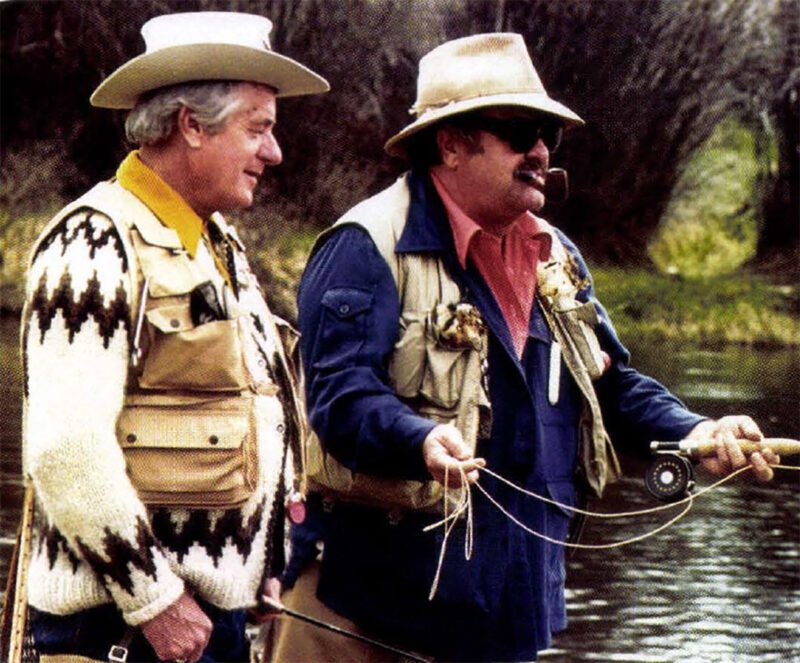
With William Conrad
Curt Gowdy left a legacy that will never be equaled. ESPN tried a version called The New American Sportsman, but stumbled in numerous attempts to find a host or segments that clicked with viewers. Seasoned sportsmen who grew up watching and listening to Gowdy didn’t buy into it; outdoors editors across the country strongly chastised the choices of hosts and subject content.
No one did it like Curt Gowdy — and no one will ever again.
Editor’s Note: This article originally appeared in the 2007 May/June issue of Sporting Classics.
 The brilliant fisherman, instructor, and public speaker Lefty Kreh is perhaps the best known, most respected, and most beloved angler in the world today. My Life Was This Big takes readers on an angling journey through the last half century, when water was big and fishermen were bigger. But, despite all that’s changed since the fifties, when Lefty began his career as a professional fly fisherman and writer, fishing is still just fishing. Buy Now
The brilliant fisherman, instructor, and public speaker Lefty Kreh is perhaps the best known, most respected, and most beloved angler in the world today. My Life Was This Big takes readers on an angling journey through the last half century, when water was big and fishermen were bigger. But, despite all that’s changed since the fifties, when Lefty began his career as a professional fly fisherman and writer, fishing is still just fishing. Buy Now
